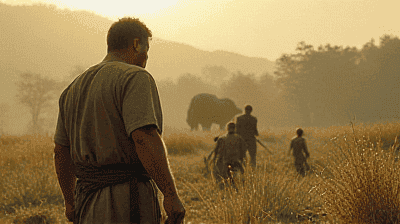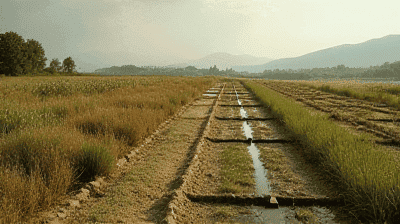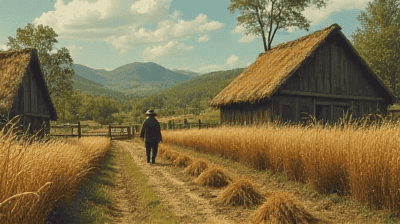
In the rapid march of modern agriculture, with its high-tech machinery and genetically modified organisms, it is easy to overlook the wisdom gained from centuries of traditional farming practices. Ancient techniques, honed over generations, have helped civilizations thrive. These methods, developed in diverse climates and ecosystems, often prioritized sustainability, biodiversity, and a deep understanding of natural systems. As the world faces challenges such as climate change, soil degradation, and food insecurity, many ancient farming techniques offer valuable lessons for modern farmers and consumers alike.
Ancient farming techniques were developed with an understanding of ecological balance and sustainability. These methods often emphasized the need to work with nature rather than against it. They were designed to maintain soil fertility, manage water resources, and preserve biodiversity, fostering resilience in agriculture.
Many traditional farming practices encourage the cultivation of diverse crops and livestock. This biodiversity is critical for ecological stability and food security. Diverse agricultural systems can better withstand pests, diseases, and climate variability, making them more resilient than monoculture systems.
These techniques are not only agricultural practices but also represent the cultural heritage and identity of communities. Understanding and preserving these practices helps maintain cultural diversity and knowledge systems that have been passed down through generations.
As contemporary agriculture seeks to address sustainability and environmental challenges, many ancient techniques can be adapted to modern farming systems. By integrating ancient wisdom with modern science, farmers can enhance productivity while minimizing ecological impacts.

Crop rotation is the practice of alternating the types of crops grown in a given area across season or year. This technique has roots in ancient agricultural societies, including those in Mesopotamia, Egypt, and China. By rotating crops, farmers can prevent soil nutrient depletion, disrupt pest cycles, and reduce the risk of disease.
Today, crop rotation remains a fundamental practice in sustainable agriculture. By rotating crops, farmers can improve soil fertility, enhance biodiversity, and increase overall yield stability. For instance, legumes such as beans and peas can fix nitrogen in the soil, benefiting subsequent crops in the rotation, such as corn and wheat. This practice reduces the need for synthetic fertilizers and can lead to healthier soils.
Companion planting involves growing different crops in proximity for mutual benefit, a technique used by ancient civilizations across the globe, from the Native American “Three Sisters” method of planting corn, beans, and squash together to traditional systems in Asia and Africa.
Today, companion planting is recognized for its benefits in pest management, pollination, and resource optimization. For example, planting marigolds with vegetables can deter harmful nematodes and attract beneficial insects, promoting a healthier garden ecosystem. By understanding which plants can benefit each other, modern organic farmers are reclaiming this age-old technique to reduce chemical pest control measures.
Agroforestry, the integration of trees and shrubs into agricultural landscapes, has been practiced for thousands of years. Ancient cultures utilized agroforestry to create sustainable food systems, combining crop and livestock production with forest resources.
Agroforestry systems increase biodiversity, improve soil health, and provide additional income streams for farmers. By incorporating trees into farming systems, farmers can enhance carbon sequestration, reduce soil erosion, and improve microclimates. Modern agroforestry practitioners are applying ancient principles to develop resilient agricultural systems that support both crops and wildlife.
Terrazzo or terrace farming is an ancient technique found in mountainous regions, particularly in Asia and South America. This method involves creating flat areas on steep terrains to optimize water usage and reduce soil erosion by slowing down water runoff.
Today, terrace farming is being implemented in regions facing terrain challenges, such as the Andes or the Himalayas. This technique enhances water conservation, improves soil fertility, and reduces erosion, allowing farmers to cultivate crops in otherwise inhospitable landscapes. As climate change increases the frequency of severe weather events, terrace farming can help farmers respond effectively to these challenges.
Seed saving is among the oldest agricultural practices, enabling farmers to select and preserve seeds from the best-performing crops for the following planting season. This practice has been vital for maintaining crop diversity and adapting to local conditions.
In an era dominated by hybrid and genetically modified seeds, traditional seed saving is becoming increasingly important for biodiversity conservation. Farmers who save and plant heirloom and indigenous seeds contribute to food sovereignty and resilience against pests and diseases. Organizations promoting seed banks and community seed exchanges are revitalizing this ancient practice and ensuring genetic diversity.
Before the advent of synthetic pesticides, ancient farmers developed their own pest management strategies, often based on observation and natural control methods. Traditional practices included intercropping, habitat creation for beneficial insects, and the use of biological controls.
Modern integrated pest management builds on these ancient practices by incorporating ecological principles into pest control strategies. By promoting beneficial insects and using crop diversity, farmers can reduce pest populations naturally, thus minimizing chemical pesticide use. Techniques such as using pheromone traps and introducing predatory insects echo ancient wisdom and offer eco-friendly solutions to pest problems.
Qanats, ancient underground channel systems for irrigation, originated in Persia and spread across various cultures, while aqueducts were developed by the Romans to transport water. These techniques allowed civilizations to efficiently manage water resources, crucial in arid regions.
Contemporary farmers are revisiting these ancient water management techniques to address current challenges related to water scarcity and inefficient irrigation practices. Implementing similar systems for rainwater harvesting and efficient irrigation can help optimize water use, reduce waste, and enhance crop yield, especially in areas facing drought and water scarcity.
Fallow farming involves leaving land uncultivated to recover soil nutrients, a practice used in traditional agriculture worldwide. Slash-and-burn techniques, where forested areas are cleared and burned to create fields, have also provided a short-term boost in soil fertility.
While slash-and-burn agriculture can have negative environmental impacts if mismanaged, sustainable variants are being recognized for their potential. Controlled fallowing and rotational farming can help manage soil health and recovery by incorporating periods of rest in crop cycles, enhancing biodiversity, and reducing the need for synthetic fertilizers.
Ancient civilizations had various methods to maintain soil health, including composting, manure application, and using green manures (cover crops grown specifically to improve the soil). These practices were essential for the sustainability of their farming systems.
Today’s organic farmers frequently employ similar soil management practices, focusing on building organic matter and improving soil health. The incorporation of compost, organic amendments, and cover crops is vital for maintaining healthy soils. With rising awareness of soil degradation, these age-old techniques provide valuable solutions for sustainable agriculture.
Polyculture involves cultivating multiple crop species in the same space, a method practiced by ancient agricultural societies across different cultures. This technique promotes biodiversity and reduces the risk of crop failure.
Modern agroecology embraces polyculture systems for their ecological benefits. Farmers using polyculture can improve overall crop resilience, biodiversity, and soil health. These systems align with sustainable practices aimed at improving food security and reducing reliance on monoculture that dominates much of modern agriculture.
The successful integration of ancient farming techniques into contemporary agriculture requires collaboration among various stakeholders, including farmers, educators, researchers, and community organizations.
Farm-Based Education: Providing training programs on traditional agricultural techniques can help farmers understand how to apply these methods effectively.
Community Workshops: Engaging local communities in workshops and hands-on training can foster interest and understanding of ancient practices, enhancing local food systems.
Research and Development: Collaborative research between traditional knowledge holders and scientists is essential for adapting and promoting sustainable ancient practices in modern contexts.
Support from policymakers is crucial in promoting the adoption of ancient agricultural techniques:
Incentives for Sustainable Practices: Government policies can provide financial incentives for farmers who adopt traditional practices that promote sustainability and resilience.
Preserving Agricultural Biodiversity: Protecting heirloom seeds and supporting seed saving initiatives through legislation can maintain genetic diversity essential for future food security.
Research Funding: Allocating funds to study traditional farming methods can enhance our understanding of their benefits and promote their application in modern agriculture.
Though the benefits of ancient techniques are clear, there are challenges to their adoption in modern contexts:
Cultural Acceptance: Some modern farmers may be hesitant to abandon industrial practices, viewing traditional methods as outdated. Addressing these perceptions through education and demonstration of success stories is vital.
Scalability: Certain ancient techniques may not be easily scalable in today’s high-demand agricultural systems. Finding ways to adapt them for modern scales without losing their benefits is essential.
Soil and Climate Variability: Traditional techniques developed in specific ecological contexts may require modification to suit modern environmental conditions, necessitating research and experimentation.

As the world grapples with the effects of climate change, soil degradation, and the need for food security, ancient farming techniques present a viable alternative. Reviving and integrating these practices into modern agriculture can enhance resilience and sustainability while preserving cultural heritage and diversity.
With increasing awareness among consumers about the environmental impact of food production, there is a growing demand for ethically produced food. Integrating ancient techniques can help fulfill this demand, allowing for food systems that prioritize ecological balance and sustainability.
Ancient farming techniques are not relics of the past but rather invaluable resources that offer insights into sustainable practices for today’s agricultural challenges. As we continue to innovate in agriculture, respecting and incorporating the wisdom of our ancestors can lead to a diverse, resilient, and sustainable food system. By embracing these time-tested methods, we can create a harmonious relationship with the land that nurtures both our crops and our communities.